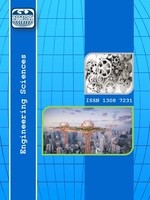MÜZİK İŞARETLERİN TEK KANAL KÖR KAYNAK AYRIŞTIRMA İLE AYRIŞTIRILMASI
Kör kaynak ayrıştırma, birden fazla sinyalin karışımını içeren bir veri kümesinden bu karışımı oluşturan her bir kaynağın tahmin edilmesi olarak tanımlanabilir. Bu işlemin kör olarak adlandırılması kaynaklar hakkında hiçbir ek bilgi olmadığını belirtmektedir. Kör kaynak ayrıştırma da tahmin edilecek sinyal sayısı kadar karışım sinyali varken, tek kanal kör kaynak ayrıştırma işleminde sadece bir karışım sinyali olduğundan kaynakların tahmini maliyetli bir işlemdir. Bahsedilen bu yöntemle herhangi bir işarete eklenmiş istenmeyen bir gürültü kaynak işaretinden ayrıştırılabilir. Benzer şekilde bu çalışmada olduğu gibi tek bir mikrofonla kaydedilmiş 2 farklı enstrümantal işaret kaynağı birbirinden ayrıştırılabilir. Yapılan bu çalışmada sürekli dalgacık dönüşümü kullanılarak negatif olmayan matris ayrıştırma ile tek kanallı olarak kaydedilen iki işaret birbirinden ayrıştırılmıştır. Önerilen yöntemin başarım analizini değerlendirmek için sonuçlar işaret gürültü oranı ve işaret bozulma oranı cinsinden değerlendirilmiştir.
Anahtar Kelimeler:
Kör Kaynak Ayrıştırma, Negatif Olmayan Matris Ayrıştırma, Sürekli Dalgacık Dönüşümü, Kokteyl Parti Problemi, Sürekli Dalgacık Dönüşümü
AUDIO SIGNAL SEPERATION WITH SINGLE CHANNEL BLIND SOURCE SEPERATION
Blind source separation can be defined as estimating each source that makes up this mixture from a data set containing a mixture of more than one signal. Calling this process as blind specifies that there is no additional information about resources. Since it has as many signals as the number of signals to be estimated on the blind source separation, estimating sources is a cost process because of there is only one mixing signal on the single-channel blind source separation process. An unwanted noise attached to any signal can be separated from the source signal thanks to said method. Similarly two different instrumental signal sources recorded with a single microphone can be separated from each other as in this study. In this study, two signals recorded as single channel were separated from each other with non-negative matrix separation using continuous wavelet transform. The results were evaluated in terms of signal noise ratio and signal distortion ratio to evaluate the performance analysis of the proposed method.
Keywords:
Blind Source Separation, Cocktail Party Problem, Non-Negative Matrix Factorization, Continuous Wavelet Transform,
___
- [1] Niknazar, M., (2014). Blind Source Separation of Underdetermined Mixtures Of Event-Related Sources. Signal Processessing: Cilt:101, Sayı:8, ss:52–64.
- [2] Nikunen, J.T. and Virtanen, T., (2014). Direction of Arrival Based Spatial Covariance Model for Blind Sound Source Separation IEEE/ACM Trans. Audio Speech Lang. Process., Cilt:22, Sayı:3, ss:727-739.
- [3] Pengju, H., Tingting, S., Wenhui, L., and Weibiao, Y., (2018). Single Channel Blind Source Separation on The Instantaneous Mixed Signal Of Multiple Dynamic Sources. Mechanical Systems and Signal Processing. Cilt:113, ss:22-35.
- [4] Smaragdis, P., (2004). Non-negative Matrix Factor Deconvolution; Extraction of Multiple Sound Sourses from Monophonic Inputs. Lecture Notes in Computer Science, Cilt:319, Sayı:5, ss:494–499.
- [5] Schmidt, M.N. and Olsson, R.K., (2006). Singlechannel Speech Separation Using Sparse Non-negative Matrix Factorization, International Conference on Spoken Language Processing (INTERSPEECH), Glasgow.
- [6] Kırbız, S. ve Günsel, B., (2009). Negatif Olmayan Matris Ayrıştırma ile Tek-Kanaldan Algısal Ses Ayrıştırma, IEEE, Antalya.
- [7] He, P., She, T., Li, W., and Yuan, W., (2018). Single Channel Blind Source Separation on The Instantaneous Mixed Signal of Multiple Dynamic Sources. Mechanical Systems and Signal Processing. Sayı:113, ss: 22-35.
- [8] Schmidt, M.N., (2008). Single-Channel Source Separation Using Non-negative Matrix Factorization, Doktora Tezi, Technical University of Denmark.
- [9] Mateo, C. and Talavera, J.A., (2018). Short-time Fourier transform with the window size fixed in the frequency domain. Digital Signal Processing. Cilt:77, ss:13-21.
- [10] Mateo, C. and Talavera, J.A., (2018). Short-Time Fourier Transform with the Window Size Fixed in the Frequency Domain (STFT-FD): Implementation. SoftwareX, Cilt:8, ss:5-8.
- [11] Choukri, D. and Mehdi, A., (2017). A New Data-Driven Deep Learning Model for Pattern Categorization using Fast Independent Component Analysis and Radial Basis Function Network. Taking Social Networks resources as a case Procedia Computer Science, Cilt:113, ss:97-104.
- [12] Vanluyten, B., Jan, C., and Bart De Moor, B.M., (2008). Structured Nonnegative Matrix Factorization with Applications to Hidden Markov Realization and Clustering. Linear Algebra and its Applications, Cilt:429, Sayı:7, ss:1409-1424.
- [13] Cardoso, J.F. and Comon, P., (1996). Independent Component Analysis, A Survey of Some Algebraic Methods, Proc. ISCAS96, ss:93-96.
- [14] Comon, P., (1994). Independent Component Analysis: A New Concept, Signal Processing, 36, 287-314.
- [15] O’Grady, P.D., Pearlmutter, B.A., and Rickard, S.T., (2005). Survey of Sparse and Non-sparse Methods in Source Separation, IJIST International Journal of Imaging Systems and Technology, 18, ss: 78-85.
- [16] Kanailal Mahato K., (2018). the composition of fractional hankel wavelet transform on some function spaces. Applied Mathematics and Computation, Cilt:337, ss:76-86.
- [17] Dai, H., Zheng, Z., Wang, W., (2018). A new ractional wavelet transform. Communications in Nonlinear Science and Numerical Simulation, Sayı:44, ss:19-36.
- [18] Lee, D. and Seung, H., (1999). Learning the Parts of Objects by Nonnegative Matrix Factorization. Nature Sayı:401, ss:788–791.
- [19] Vasiloglou, N., Gray, A.G., and Anderson, D.V., (2009). Non-Negative Matrix Factorization, Convexity and Isometry. Computer Science, Artificial Intelligence.
- Başlangıç: 2009
- Yayıncı: E-Journal of New World Sciences Academy
Sayıdaki Diğer Makaleler
THE EFFECTS OF SOLAR CAR DESIGN ON PERFORMANCE
Adem YILMAZ, Selman AYDIN, Rifat YAKUT, Berat Fırat DALĞIÇ
MÜZİK İŞARETLERİN TEK KANAL KÖR KAYNAK AYRIŞTIRMA İLE AYRIŞTIRILMASI
Hüsamettin ÇELİK, Fatih Yavuz ILGIN, Yusuf SEVİM
CASE STUDY ON THE IMPLEMENTATION OF THE AUTONOMOUS DRIVING SYSTEMS
